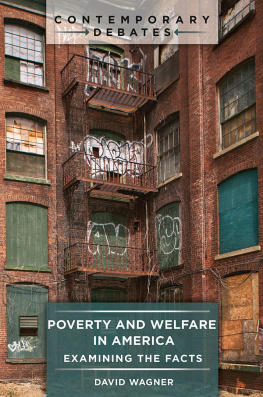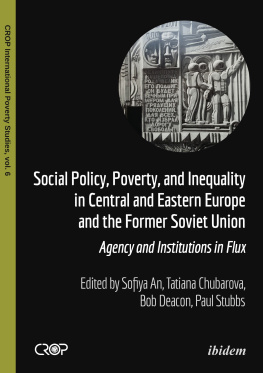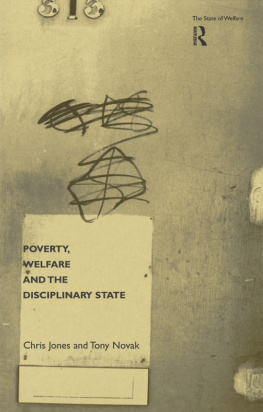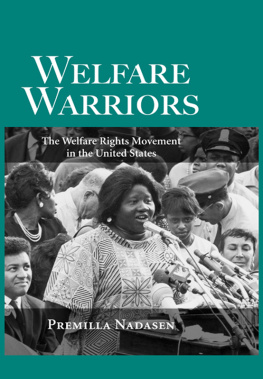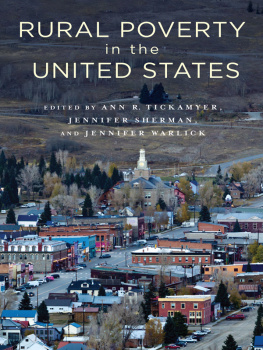Poverty and Social Welfare in the United States
Poverty and Social Welfare in the United States
edited by
Donald Tomaskovic-Devey
First published 1988 by Westview Press, Inc.
Published 2019 by Routledge
52 Vanderbilt Avenue, New York, NY 10017
2 Park Square, Milton Park, Abingdon, Oxon OX14 4RN
Routledge is an imprint of the Taylor & Francis Group, an informa business
Copyright 1988 Taylor & Francis
All rights reserved. No part of this book may be reprinted or reproduced or utilised in any form or by any electronic, mechanical, or other means, now known or hereafter invented, including photocopying and recording, or in any information storage or retrieval system, without permission in writing from the publishers.
Notice:
Product or corporate names may be trademarks or registered trademarks, and are used only for identification and explanation without intent to infringe.
Library of Congress Cataloging-in-Publication Data
Poverty and social welfare in the United States/edited by Donald
Tomaskovic-Devey.
p. cm.
ISBN 0-8133-7458-8
1. Public welfare--United States. 2. United States--Social
policy. 3. Poor--United States. I. Tomaskovic-Devey, Donald,
1957
HV95.P68 1988
362.5'8'0973--dc19 87-21311
CIP
ISBN 13: 978-0-367-28403-9 (hbk)
Contents
Donald Tomaskovic-Devey
Irwin Garfinkel and Sara McLanahan
Teresa Arendell
David J. Maume , Jr.
Donald Tomaskovic-Devey
Jimy M. Sanders
Michael Morris
Mark R. Rank
Rosemary C. Sarri and Carol Crill Russell
Susan Gotsch-Thomson
Donald Tomaskovic-Devey
Guide
A society must come to grips at some point with its failures. The United States is an affluent society that tolerates the impoverishment of one-eighth of its population. Our social welfare responses to poverty are typically half-hearted and punitive. We do not like or trust the poor, perhaps because poverty is so incongruous in an affluent society. Our ideological and academic predilections are to "blame the victim" rather than to confront systemic failings. This volume confronts our failings as a society by focusing on the creation of poverty by normal economic and demographic processes and the activities of the welfare state and politics in ameliorating and occasionally creating poverty.
This book was born of my surprise and excitement at the sheer volume of academic work on poverty and social welfare being reported at sociological conferences around the United States in 1985 and 1986. It seems as if sociologists in particular are paying more attention to these issues than has been typical in the past. This is not to say that this book is a purely sociological treatment of poverty and social welfare. All of the chapters to follow are profoundly interdisciplinary regardless of the academic affiliation of the authors. All of the papers display, however, a sociological insight into the social embeddedness of poverty and social welfare programs in broader political economic and cultural systems. Within this volume the poor are not incongruous deviations in an affluent society. Rather, poverty and our social responses to poverty are generated by larger social forces.
Hopefully, this book will have many audiences. Teachers may wish to use it in advanced undergraduate and graduate level courses to introduce students to current debates about poverty and social welfare and to analytic strategies for resolving those debates. Economists, the main social science investigators of poverty, will find a somewhat different set of explanations and assumptions guiding these more sociological approaches to poverty and social policy. Sociologists and political scientists will find a rich and varied source of inspiration for future research. Finally, politicians, social policy analysts and activists will find not only a framework for understanding a frustrating and seemingly intractable social problem but also a series of loosely integrated policy proposals for addressing the failings of an affluent society.
Donald Tomaskovie-Devey
This collection was made possible by the splendid cooperation and hard work of the contributors. All of these papers are original contributions to this volume, many of which were edited and/or rewritten to better fit the theme of the volume. Jean Pittman did the wordprocessing and composition that produced this manuscript. Without her efforts the project simply would not have succeeded. Carol Gilbert helped with the manuscript as well.
I owe a particular debt of gratitude and respect to S. M. (Mike) Miller who, although not among the authors in this volume, has influenced greatly my approach to poverty and social welfare. To the extent that I have done a good intellectual job as editor he certainly deserves some of the credit.
Donald Tomaskovic-Devey
1
Poverty and Social Welfare in the United States
Donald Tomaskovic-Devey
This volume is about poverty. The chapters that follow represent some of the most current and informative research being done on poverty in the United States. The topics covered include who is poor, the antecedents of poverty on both the individual and social structural levels, some consequences of poverty, the role and limitations of the current U.S. welfare state in both the amelioration and (occasional) creation of poverty, and a series of policy recommendations for more effective assaults upon the problem of poverty in the United States. As such it is an ambitious book which endeavors to give the student of poverty and social welfare a broad look at the processes and policies associated with poverty in this country. The papers are serious pieces of research, clear headed, generally empirical, and well presented. For readers new to the field many myths that surround poverty and the welfare state will be dispelled. For academics active in the field some new ways of understanding and dealing with poverty and social policy will be outlined.
This introductory essay has two purposes. First, it will serve as a broad overview and introduction to understanding poverty and social welfare in the United States. As such, it will cover much territory quickly in order to give the reader a perspective with which to evaluate and understand the more substantive chapters that follow. The second purpose of this essay is to give the reader a road map that makes clear the location of the research to follow on the broad landscape of poverty and associated social policies. These purposes will be accomplished simultaneously as I foreshadow the insights of the papers to follow in this overview essay.
Understanding and Defining Poverty
Understanding Poverty
When we speak about the 'poor' who are we speaking of? What images are called to mind, what life experiences are implicated, and what social costs does the existence of a poor population imply for the non-poor? In the United States we have a general imagery of a population that has few material possessions, low income, often derived from an inability or reluctance to get a job, and homes in substandard even dangerous places. Poverty is understood as both a cause and result of a host of social ills such as teenage pregnancy, crime, drug abuse and other types of socially undesirable behavior. []
These general social images suggest that poverty is often conceptualized as both material deprivation and a lack of social integration. Material deprivation is, of course, the dominant consequence of poverty for the individuals and families who are poor. The social problems that transcend the poor population and involve the whole society are a consequence of the violence to the self and family that material deprivation visits upon those who are poor, particularly those who are persistently poor. From this perspective poverty is best understood as a social relationship between the poor and the standards of living and behavior commonly expected in the larger society. The poor are stigmatized, socially isolated and their sense of self-efficacy threatened (if not destroyed) by being unable to participate fully in a society characterized by and which values highly affluence. I do not mean the affluence of the very rich but the simple affluence of normal social participation. Having the money to spend on clothes for school, church and social visiting is denied the poor. Travel to work, to the homes of friends and relatives, or to outings at the beach or lake on a hot summer day are denied to those without the money to afford a car or mass transportation. It is no wonder that we see large concentrations of the materially poor in cities with good mass transportation systems. Here at least mass transportation reduces the cost of social participation and so acts to ameliorate the social experience of material deprivation.




